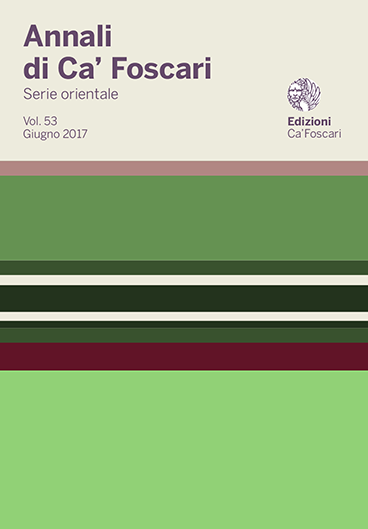Rivista | Annali di Ca’ Foscari. Serie orientale
Fascicolo | 53 | 2017
Articolo | On the Kabīsa of the Saffarid Amīr Khalaf ibn Aḥmad
On the Kabīsa of the Saffarid Amīr Khalaf ibn Aḥmad
Abstract
The Persian risāla titled Nawrūznāma is a classical work of adab, featuring an account on the history of Iranian calendar and materials (notices, anecdoctes etc.) about courtly and popular customs linked with the Iranian New Year Day. Here we will discuss an isolated notice about an intervention on the solar calendar of the Iranian tradition performed by Khalaf ibn Aḥmad, amīr of Sīstān. The inaccuracy of the Nawrūznāma on historical and astronomical matters does not reduce the importance of this ancient source as a literary work, revealing of its own time's mindset. In fact, the text gives us a plausible clue about the importance of the long reign of Khusraw I for the history of Persian chronology, thus supporting some of the hypotheses traced out by modern scholars. Moreover, it recounts of actual celebrations of the beginning of Spring – to be called Nawrūz – at the time of Abbasid caliph al-Ma’mūn. The conclusion is that, although roughly, the Nawrūznāma not only corroborates other extant sources on the existence of alternative – or parallel – ways of time-reckoning in the Iranian world, but also opens the way for a more precise reconstruction of the relation between a well-ordered social life and kingly governance, that, in Seljuk times, was going to be increasingly thought as essential.
Presentato: 25 Novembre 2016 | Accettato: 12 Maggio 2017 | Pubblicato 20 Giugno 2017 | Lingua: en
Keywords Khalaf ibn Aḥmad • Zoroastrian calendar • Nawrūz • Nawrūznāma • Kabīsa • Iranian calendar
Copyright © 2017 Simone Cristoforetti. This is an open-access work distributed under the terms of the Creative Commons Attribution License (CC BY). The use, distribution or reproduction is permitted, provided that the original author(s) and the copyright owner(s) are credited and that the original publication is cited, in accordance with accepted academic practice. The license allows for commercial use. No use, distribution or reproduction is permitted which does not comply with these terms.
Permalink http://doi.org/10.14277/2385-3042/AnnOr-53-17-4




